To reduce the cost of sewerage construction, the depth sewer pipe must be calculated correctly. With an increase in the depth of the pipeline in the ground, as a rule, its installation also becomes more expensive. In addition, it affects the possibility of effective operation. sewer system. Therefore, taking into account technical standards and climatic features of the area, it is necessary to choose the minimum possible depth.
Factors affecting the depth of sewerage
The calculation of the depth of laying sewer pipes takes into account the following parameters:
- climate mark, which displays the power of annual soil freezing, this indicator is regulated by the normative act SNiP 2.01.01.82;
- technical properties of materials used in construction;
- specific features of the pipeline;
- the depth at which the sewer system is connected to a collector or septic tank;
- terrain;
- the maximum dynamic load acting on the sewer system (if the laying is carried out under the road).
The depth of soil freezing is a fundamental factor
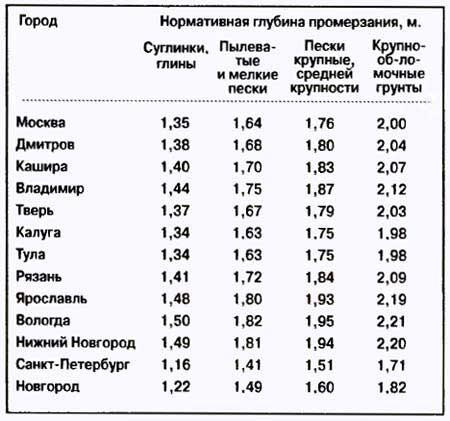
The design of sewer pipelines begins with determining the depth of freezing of the soil into which the sewer will be laid. The maximum depth, measured in standard units of measurement, below which moisture in the soil does not crystallize, is considered the mark of soil freezing. The depth of the sewer pipes depends on it.
Below the freezing mark, the soil does not freeze, its volume does not increase and, therefore, there is no effect on the pipeline laid in it. The depth of freezing for each region can be found in the collection of standards "Construction climatology", in the section of cartographic materials.
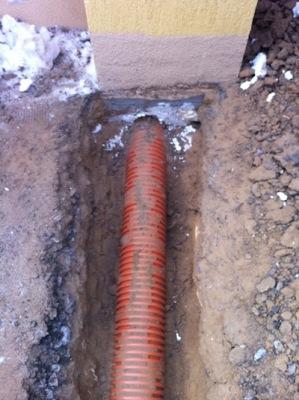
If for some reason it is not possible to access the collection, the local metrological service will help. Employees of the organization will tell you the value of the indicator, which was revealed as a result of many years of studying the properties of the soil. For example, studies have shown that in central Russia, the freezing depth is on average 1.4 m, in the North region - 1.8÷2.4 m, and on the Black Sea coast - 0.8 m.
A feature of the construction of sewerage is that, in contrast to water networks, the depth of the sewer pipes is calculated by subtracting a certain distance from the freezing depth indicator of the soil, since the sewer pipes transport effluents of positive temperature. The value by which the laying depth is reduced depends on the diameter of the sewer pipes:
- with a diameter of up to 0.5 m, it is 0.3 m. For example, in order to sewer into a house using pipes with a diameter of 0.4 m, in an area with a soil freezing depth of 1.6 m, it is necessary to lay pipes in the soil to a depth of 1, 30 m (1.60 - 0.30 = 1.30 m);
- at larger diameter pipes - 0.5 m. For example, to improve the same house, but using pipes with a diameter of 0.6 m, the required depth of laying sewer pipes will be 1.10 m (1.60 - 0.50 \u003d 1.10 m) .
Having completed the calculation of the sewer pipes, they begin to dig trenches into which the pipeline is then laid. It is possible to reduce earthwork costs by making trenches as narrow as possible. Reducing the depth of the pipes is prohibited.
Relief features
The depth of laying sewer pipes will also greatly depend on the features of the terrain. When constructing a sewer on a relatively flat area, the depth will be the same along the entire length of the pipeline.
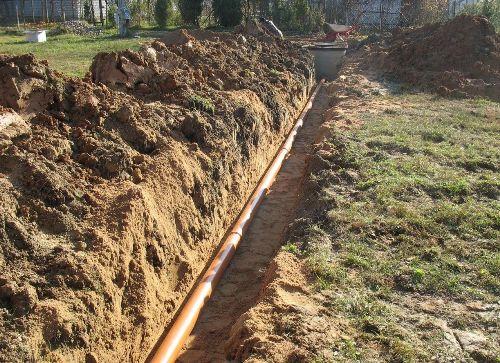
But if the landscape has pronounced differences in height, the depth of the sewer pipe is calculated from the lowest point of the landscape on the site. In this case, the statement that the higher the pipes are laid in the ground, the less cost on materials and earthworks, is not true, because the result will be a complex undulating construction of the highway. For uneven terrain, it is advisable to build a direct sewer pipeline to a constant depth with a certain slope.
Pro tip: When the sewer system is laid in places where vehicles or people move, it is necessary to take into account the dynamic load on the polymer pipeline. In such areas, laying should be carried out in a closed way or reinforced polymer corrugated pipes should be used.
Technical characteristics of sewer pipes
Ceramic and metal sewer pipes have been replaced by their modern counterparts - plastic pipes. The advantages of polymer products are enough:
- acceptable price;
- durability;
- ease of transportation to the installation site;
- ease of installation, etc.
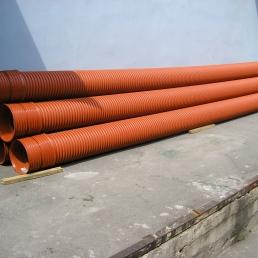
However, there is also a significant drawback: the depth of laying polymer pipes in the soil is limited. Therefore, before purchasing the material, carefully read technical specifications products contained in the manufacturer's instructions.
When constructing a sewer system from polymer pipes, they are mainly guided by the experience of building and operating identical communications in a particular region. And in the absence of reliable data, the calculation of the strength of polymer products is carried out according to SP 40-120-2000, which regulates the principles for the design and installation of plastic sewer pipelines.
Pro tip: When reading information about polymer sewer pipes, pay special attention to the laying depth indicator. It must necessarily meet all the conditions of the sewerage project on your site. Otherwise, the pipeline may not withstand the pressure of the soil and fail, which will lead to the need to dismantle the sewer and build a new one.
Additional aspects
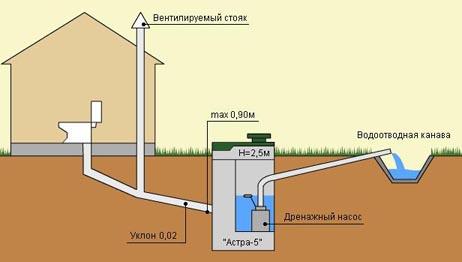
The calculated depth of laying sewer pipes is an approximate value. It is subject to mandatory adjustment taking into account the length of the pipeline, the landscape of the site and design features sewer systems.
Private houses are most often supplied with gravity sewers. In such a system, when laying, it is necessary to observe the slope of the pipeline towards the treatment plant by 0.02 m for each running meter pipes (for example, with a sewer pipeline length of 20 m, the depth of the point at which the pipes connect to the septic tank will be 0.40 m more).
If a pump is installed in the sewer network that performs the forced transportation of effluents through the pipeline, a slope is not needed. The operation of the pump will not allow wastewater to stagnate and freeze at low temperatures, forming an ice plug. However, a pressure (forced) sewer system is less popular in the construction of private houses.
A qualified calculation of the depth of the sewer pipeline ensures its long and efficient operation, the absence of breakdowns and other problems. In addition, knowing this indicator, you can choose the best option laying pipes and thus reduce costs in acceptable ways.
The arrangement of the sewer system requires the most scrupulous attitude to all stages of the process, including depth, slope, and reliability of connections. Each of these factors has a great influence on the quality of the entire system. Negligence is unacceptable here, if there is no self-confidence, it is better to turn to professionals.
Laying depth of the sewer system
Modern sewer systems significantly improve the standard of living in a private house. If in previous years a toilet on the street was perceived as an unpleasant necessity, inseparable from a private house, today it is a sign of laziness of the owners or their extremely low income. Moreover, in the first case, you can get out of the situation by hiring professionals who will perform absolutely all the work.
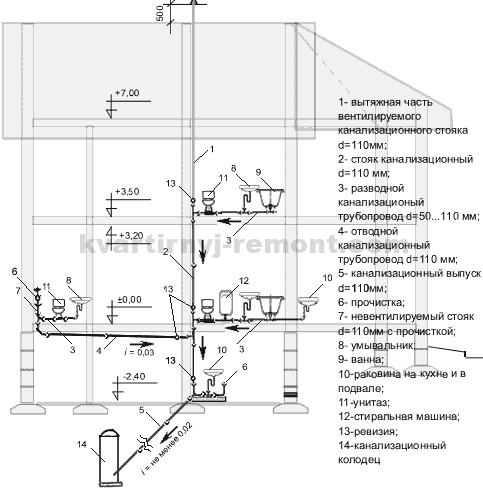
Currently, more often a septic tank is installed in it. For him, you need a pit corresponding to its size. Between the septic tank and the house must be left more than 5 meters. Deepen the septic tank by about one and a half meters. For greater reliability, a concrete pad or concrete container is equipped at the bottom of the pit. Such a structure will not allow the soil to damage the body of the septic tank with its weight, protect it from ground water.
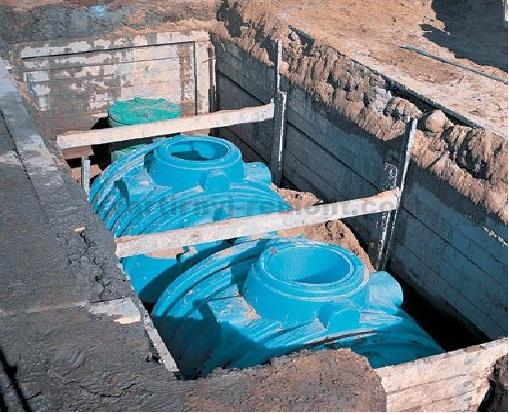
The depth of the pipeline depends on the depth of the septic tank.
Advice! The pipe laid between the building and the septic tank must be straight. Knees, turns will provoke the appearance of blockages.
Before arranging the sewer system, you should find out what is the average freezing depth in your area. Pipes need to be laid a little lower than these figures. Usually, the depth at which sewer pipes are located in a private house in the south is more than 50 cm. In the central part of the country, where the climate is harsher, the depth of sewerage in a private house is at least 70 cm. These figures are especially significant if sewer pipes are located under the platforms or under the paths, which are freed from snow in winter.
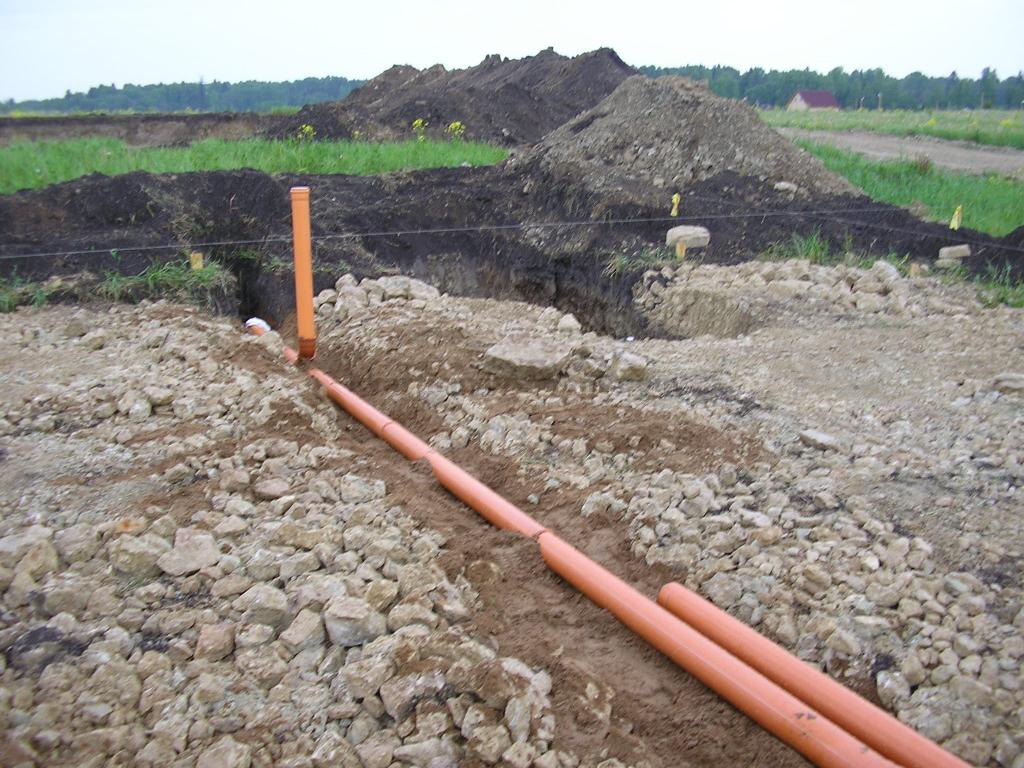
Features of laying sewer pipes
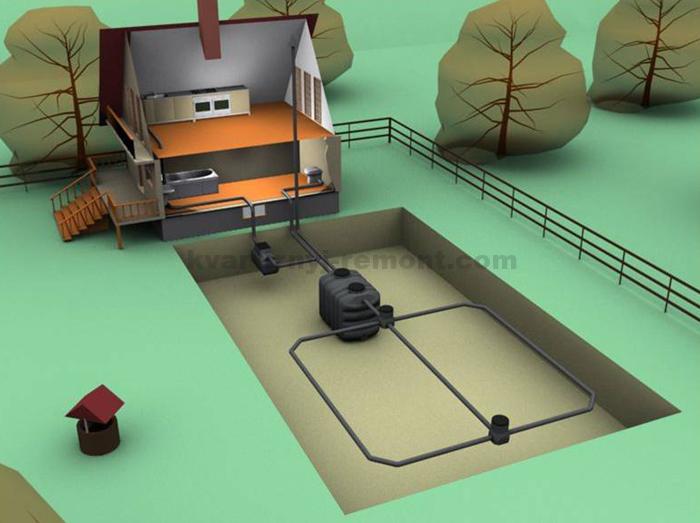
Laying sewer pipes must be carried out in accordance with the following rules:
- pipes of the required diameter must be used;
- must be respected standard rate slope (about 0.03 m per 1 linear meter of pipe);
- it is permissible to use pipes from different materials, but in one pipeline, the pipes must match in material.
The depth of the pipeline can be determined based on the following points:
- the nature of the site (its relief, soil features);
- the exit point of the sewer pipe from the house.
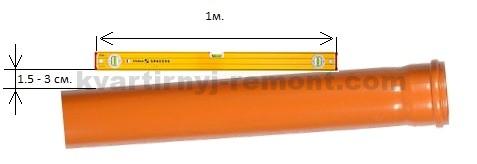
The angle of inclination is needed so that the wastewater flows by gravity, in this case it is not necessary to install a pump, excess dirt will not accumulate inside the pipe, which can cause blockages. For the same purpose, the outer part of the system is performed without turns. Here, indoors, the sewerage laying scheme in a private house allows pipe turns, this will not become a serious obstacle to the functionality of the system. If you allow the outer part of the sewer system to turn, you will definitely have to tear off these pipes to remove blockages. Consequently, neglect of these rules can create very serious problems that are not always really quickly solved.
Advice! If it is impossible to lay a sewer pipe without turns, a well must be made at the turn point, into which it will always be possible to penetrate and eliminate the blockage in this area. This technique allows you to lay a sewer pipeline in any area.
Why is laying depth important?
The main reason for the need for too careful attention to the depth of pipe laying is the possibility of freezing. If this happens in the middle of winter, the residents of the house will be left without the ability to use the sewer until warm days, when the icing melts. Even minimal ice buildup inside the pipes will lead to blockages and a decrease or complete cessation of patency. This is a natural result of the narrowing of the lumen of the pipe. Getting rid of emerging blockages in places where pipes turn into outdoor system wells contribute.
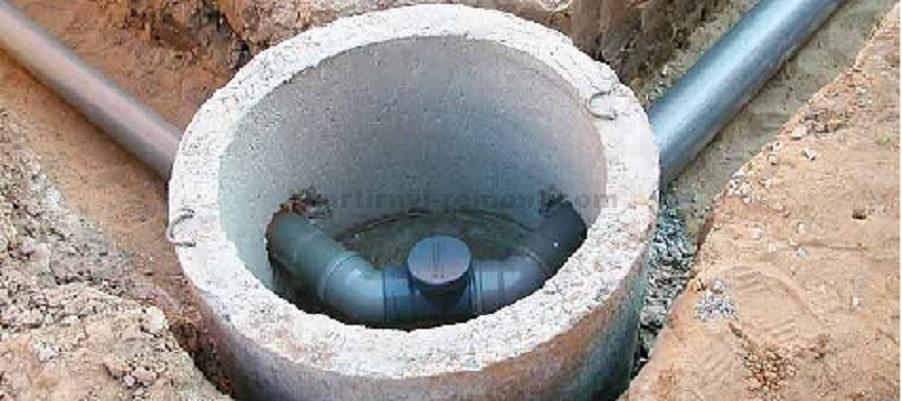
Such convenient fixture allows you to control the work of the sewerage, in time to eliminate emerging problems. It is not very difficult to make it, but it brings a lot of comfort to the operation process.
Accounting for the depth of soil freezing is a fundamental requirement. In order not to spend money on arranging deeper trenches than necessary, you need to have a clear idea of the depth of soil freezing in a given area. Below is a table to help guide you in this matter.

How to properly equip thermal insulation?
In cold regions, it is recommended to supplement the sewer pipeline with thermal insulation. This technique allows you to extend the service life, eliminate the possibility of freezing at very low temperatures. Most often, polyurethane foam is taken for this purpose. If the pipe is wrapped with polyurethane foam, and a polyethylene sheath is made on top, the pipe will not be afraid of frost.
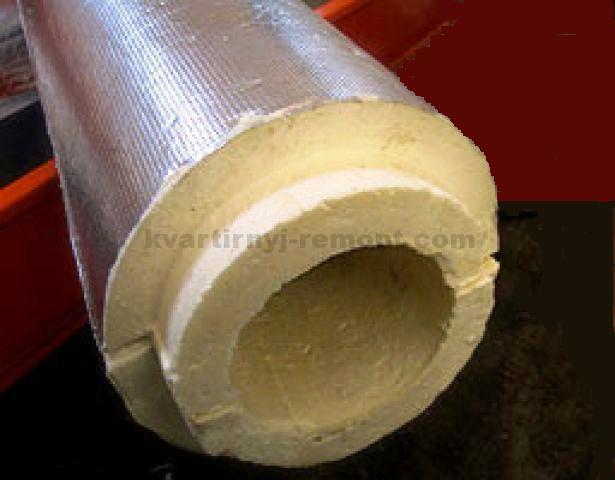
If pipes are laid below the possible freezing point, then the pipes will never freeze. In this case additional protection made for extreme cold weather. When performing thermal insulation Special attention give joints and turning points. It is these zones that tolerate the effects of cold quite poorly. So warming the turning points is a must.
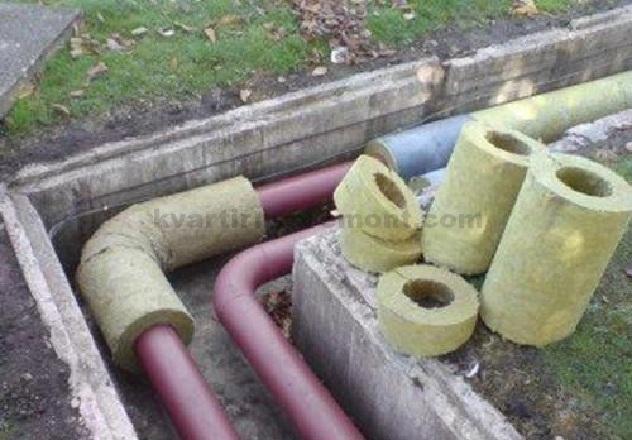
In Europe, a more technologically advanced method is used. An electric cable is launched near the pipeline; if necessary, it acts as a heater for the pipe. For many residents of our country, this method is too expensive, because paying for energy is not the smallest item of expenditure. Therefore, it is necessary to monitor the depth of pipe laying. In the central regions, it is better to choose a depth of 1m. And in the northern regions, it is desirable to dig deeper trenches and carry out high-quality thermal insulation. To do this, you can use mineral wool or fiberglass. If the pipes are located above the ground, they are also insulated with similar materials. Since they can fill with water, waterproofing will be necessary for outdoor use.
Video - Installation of external sewage for insulation
The interior of the sewer system of a private house
Video - Installation of sewer pipes
The external part of the sewer system of a private house
The main requirement is to ensure proper bias. The only correct drain is gravity. Too low a speed will cause blockages. Too fast movement of effluents - to accelerate the destruction of pipes.
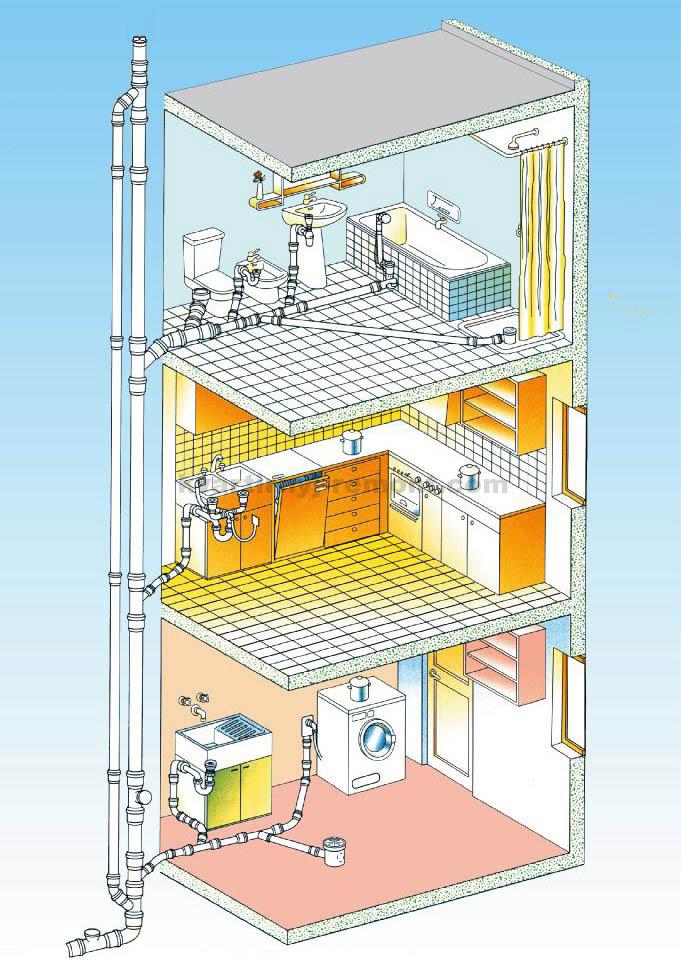
The sewerage laying scheme in a private house includes a characteristic of the features of the pipe exit from the room. The rules for removing a pipe from a house depend on the type of foundation. At strip foundation the output is arranged on the side. With slab - the pipe is laid from top to bottom, for this a pipe section and a 45 ° elbow are used. To equip the sewer, a pipe-sleeve is laid in the foundation in advance, through which the main pipeline is then removed. Such a base is needed to protect the pipeline from excessive pressure and potential destruction.
From the exit point to the septic tank / cesspool the pipe is laid evenly, without bends. In the septic tank, the drain pipe is inserted at the top. This is done to provide a place for the accumulation of waste.
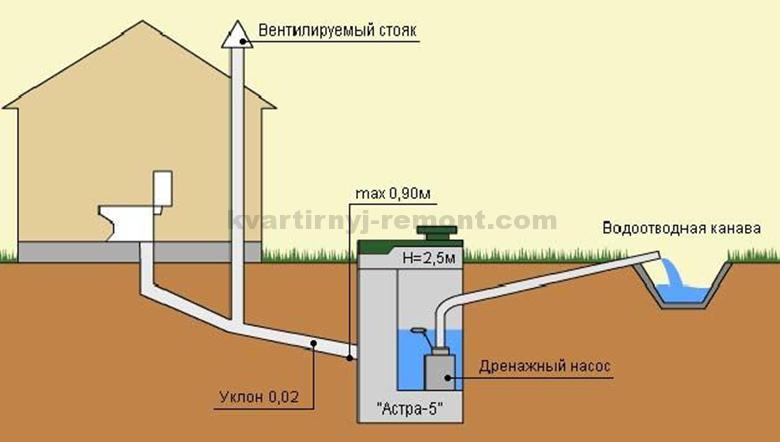
In order not to be mistaken in the depth of laying the pipe, you need to find out how things are with the neighbors who have already equipped their own drain. If they have problems with pipe freezing, you need to dig your pipe deeper. No matter how deep the pipe lies, in any case, a slope is needed. Usually they make 2 - 3 cm per linear meter.
- Must be done first detailed diagram piping inside the house. This will reduce time and financial costs by providing all the best options.
- Pipes run towards the riser or to the septic tank, sharp corners excluded.
- The riser on each floor must be equipped with a tee designed to service the sewer system for quick cleaning.
These articles are usually viewed as well.
Owners of private houses are less and less satisfied with the amenities in the yard with a primitive pit for collecting waste. The organization of external sewerage is a condition for creating full-fledged and comfortable living conditions. One of the important questions for the owner country house- how deep to bury the sewer pipe. The depth of pipe laying and installation features of the external section of the sewerage system affect the continuity and durability of operation.
Sewerage device of a private house
The sewer system of personal home ownership is conditionally divided into two components:
- internal, located in the house;
- external, laid outside the house along the adjacent plot or under it.
The internal sewer system includes outlets for bathrooms and risers. The external one is sometimes limited to a channel into the central sewer branch. The most a complex system- autonomous. It includes not only a pipeline through which the spent environment from the bath, washbasins and toilet bowl, along with fecal waste, is removed from the room, but also a septic tank. The latter is equipped independently or purchased: factory multi-chamber models guarantee a good degree of cleaning and a minimum of environmental impact.
And in the case of a centralized collector, and with autonomous waste treatment, it will be necessary to decide at what depth the sewer pipe should be, connecting the building with the rest of the communication elements. Errors in the calculation of this indicator lead to a number of consequences:
- accumulation of sewage;
- pipe freezing and ice plugs in winter;
- appearance bad smell in the area of the pipe;
- Difficulty in the operation of the site through which the system passes;
- accidents when changing the purpose of land.
The sewer pipe connecting the outlet of the internal channel and the septic tank or the global system has only one task: uninterrupted year-round removal of waste products from the premises and from the site in compliance with sanitary norms and prescriptions. The depth of the sewer pipe in a private house and the direction of the laying are of fundamental importance.
Requirements for the depth of the sewer pipe
Scheme of the depth of laying sewer units for middle lane RF
Work technique and requirements for systems that directly affect the condition environment are regulated by regulations. For the construction sector, the reference point SNiP is a set of building codes and rules. Except mandatory requirements the depth of the sewer pipe in a country house is calculated taking into account individual conditions. Properly choose the type of laying, depth, method of insulation and providing a natural drain angle can only masters with experience in a particular region. Self-taught people have to navigate the legislative framework and general recommendations.
SNiP norms
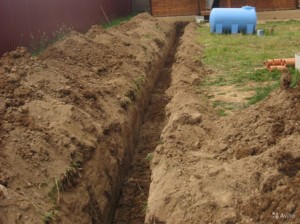
Channel for external sewage
The regulatory documents reflect the instructions for the arrangement of all significant systems of private households. The depth of sewer pipes and the level of the sewer exit point from a low-rise building are clearly specified in SNiP.
Exit sewer riser should be located 30 cm above the level of soil freezing, but this figure should not exceed 70 cm. This is the standard for plots free from development, along which no highways pass and no construction is underway. The rule applies to systems with pipes with a diameter of not more than 50 cm. Sewer networks with pipelines of a larger cross section are laid to a shallower depth, but work is prohibited in the area of large-scale communications: employees of service organizations must have uninterrupted access to the channel.
The second indicator regulated by SNiP is the recommended slope. The sewer systems of the private sector are gravity-fed, waste disposal occurs naturally. The network map is drawn up taking into account these requirements.
A map of average soil freezing rates can be found on the web; it will tell you what the depth of sewer pipes should be at a particular climatic point.
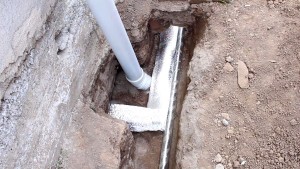
Experienced craftsmen it is recommended to take into account when laying sewer systems not only the requirements written on paper, but also the features of a particular region. Some basic data are very outdated, because even the Trans-Urals and Siberia are not threatened by severe cold. But there were reliable heaters that can compensate for low temperatures and protect the pipe from freezing. For the middle lane, for example, the Moscow region, depths are recommended:
- 50 cm for the entry point to the sewer drain;
- 1.2–1.5 m for the main pipe with the required slope to the collector inlet.
Such a depth of laying sewer pipes in a country house is sufficient for uninterrupted flow of waste fluid. The temperature of the flowing liquid will save you from freezing in rare cold weather: water enters the sewer no colder room temperature. The system should not be filled with liquid: this is the main condition for uninterrupted operation. An empty pipe cannot freeze: the frost that appears is instantly washed off with warm liquid.
Video: how to properly lay sewer pipes in a country house
When creating an autonomous sewer system, coordination with the supervisory authorities is required. Consultation with a specialist with experience in a particular region is desirable. Even the SNiP states that the work on each of the landscaped areas is individual and must take into account the entire infrastructure of the zone.
During the construction of any engineering networks trade-offs have to be made to create efficient schemes and at the same time reduce construction costs. For example, when defining a parameter such asthe depth of the sewer in a private house, one should take into account not only the level of soil freezing, but also the cost of excavation.
When building a sewerage system in a private house building regulations provide for laying the outer part of the pipeline in the ground. Therefore, the question of how deep to bury a sewer pipe is relevant for each private developer. Let's figure out how deep to bury the sewer so that the system functions without problems.
What to consider when choosing the depth of the pipes
Among the most important parameters that help determine what the depth of the sewer pipe should be, the following should be highlighted:
- The level at which the soil freezes and the depth of soil water;
- The depth of the entry point to the collector or septic tank;
- Strength characteristics of pipes;
- Dynamic loads exerted on the pipeline by vehicles moving on the surface.
Taking into account these parameters, a sewerage system is designed in a private house: the laying scheme and depth are determined for reasons of economic and practical benefits.
climate factor
Many people believe that the depth of the sewerage should be greater than the depth of freezing of the soil, since this is how the water supply system is installed. But how to determine this value?
For this, it is worth referring to regulatory documents, namely SNiP 2.01.01.82. It is in this version of the document that there is a map of zones indicating the depth of soil freezing. From this map, it is easy to determine that this value for the Moscow region is 1.4 meters, and, for example, in the area near Sochi - only 0.8 meters.
However, the above calculations, as a rule, are valid only for large objects. In the construction of residential buildings, the determination of the level of the depth of the sewer pipe is determined somewhat differently.
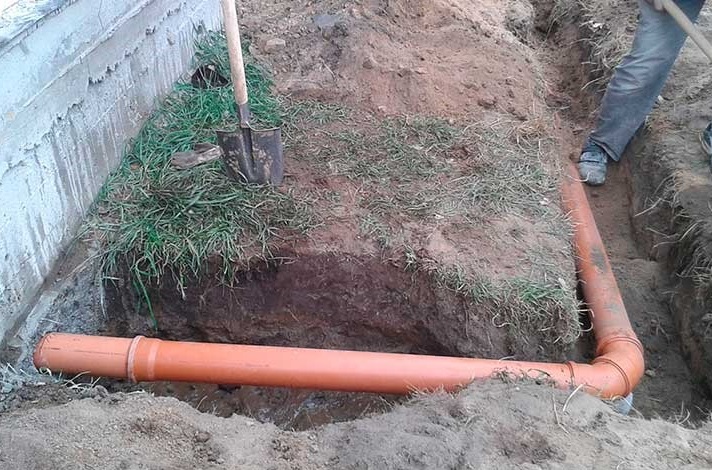
The fact is that during the construction of housing, sewer systems, as a rule, are planned to be gravity-flowing. That is, it will be important to observe the required slope when laying pipes, which can turn into a real problem, especially if the pipeline is long.
When determining the depth of the sewer in a private house, one should also take into account which treatment plant is planned to be installed at the end of the pipeline being laid. The greater the depth level of laying sewer pipes, the deeper the pit will have to be prepared for a septic tank.
And it is undesirable to deepen the treatment plant too much. And the point is not only that it is difficult to dig a hole of great depth. The septic tank is installed so that only its main effluent storage will be buried, and its cover is above the ground surface.
It should also be taken into account that the pipeline can drip, that is, leak, and too deep laying will make repairs difficult, especially in winter. In view of the foregoing, in most cases, the depth of the sewer pipe is selected without taking into account the depth of soil freezing. Moreover, there are arguments in favor of laying a sewer pipe in a private house at a shallower depth:
- Firstly, drains have at least room temperature, or even more high temperature. Consequently, the frost that forms on the inner walls of the pipes is regularly washed off with warm water.
- Secondly, if home sewage is not used for some time, then the pipes are empty, that is, there is simply nothing to freeze in them.
- Thirdly, the heat coming from the treatment plant or septic tank, which is formed during the treatment and decomposition of wastewater, penetrates into the sewer pipes.
![]()
Thus, there is no need for the depth of the sewer to be greater than the freezing depth. For the middle lane, it is necessary to draw a pipe out of the house at a depth of 0.5-0.7 meters, and then dig a ditch and lay pipes for external pipelines, adhering to the required slope.
Warming
If installation is planned outdoor sewerage at a shallow depth, then an obligatory stage of construction is insulation. At the same time, sewer pipes are wrapped in a layer of insulation or a system of heating cables is installed on them, which prevents the drains from freezing.
Advice! If it is decided to insulate pipes when laying them open way(without the use of trays), then they should be carefully waterproofed from above.
The use of pipe insulation and heating cables has to be resorted to when building houses in areas with a harsh climate. After all, there the depth of soil freezing can be tens of meters. Naturally, laying communications so deeply is irrational, so pipelines are protected from frost in other ways.
Pipe strength
If the depth of the sewerage is chosen, then the strength characteristics of the pipes cannot be ignored. As a rule, pipes made of plastic or PVC are more often used today for external networks.
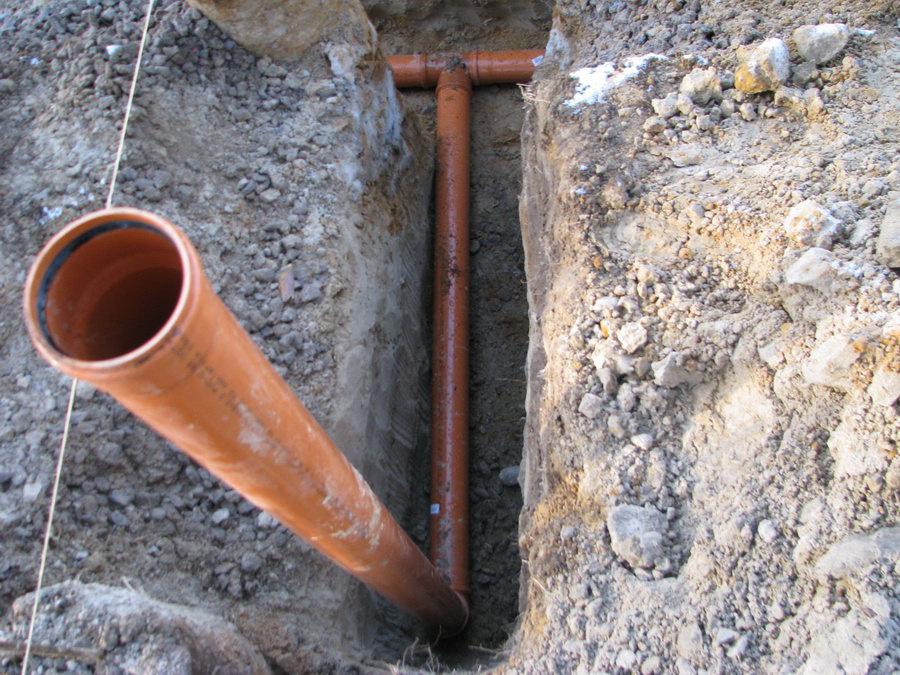
When choosing pipes, it is necessary to familiarize yourself with the recommendations for use given by the manufacturer. Pipes designed for laying on the street have increased strength and resistance to external influences than pipes that are designed for internal networks.
Advice! If you plan to install the pipeline at great depths or under the roadway, then you should use the closed laying method and purchase pipes with increased rigidity. For example, corrugated two-layer pipes, made of polyethylene.
For outdoor work, as a rule, orange-brown pipes are used. Special additives are added to the plastic of these products, which give the pipes increased rigidity and the ability to withstand high loads. Such pipes can be laid to a depth of up to three meters.
Earthworks during the construction of external sewerage
Today, in the construction of a private house, both machine earthworks and manual earthworks are used:
- The easiest way, of course, is to use special equipment. In this case, the dimensions of the trench are determined by the diameter of the pipes and the required slope. So, if you plan to use a pipe with a cross section of 110 mm, then the width of the trench should be 600 mm, and how to determine required depth, described above.
- If there is building on the plots, the use of special equipment may not be possible, so earthworks will have to be done manually. The trench dimensions are similar. The depth of the excavated trench should be 50 mm more than the planned level of laying the pipe, since more sand will need to be added.
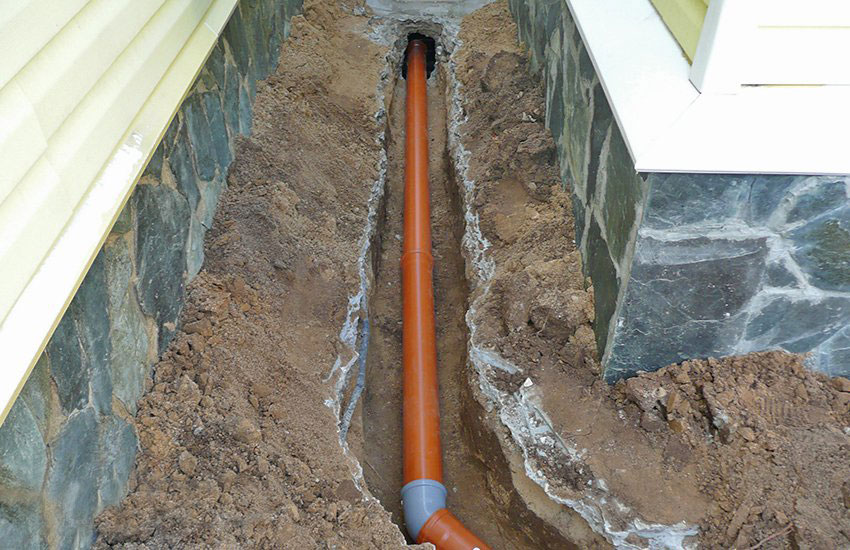
Stages of installation of the external pipeline
- Sand is poured into the bottom of the trench (layer 50 mm) and compacted manually;
- Prepare necessary details- pipes, fittings, seals, etc.
- The laying starts from the foundation. As a rule, a hole for the withdrawal of sewage is organized even during the construction of the foundation. But if this has not been done, the diamond drilling method is used.
- For a tighter connection, use silicone grease. To do this, the lubricant composition is applied to the smooth end of the pipe and inserted into the socket into which the sealing cuff is inserted.
- If it is necessary to arrange a turn, then smooth bends should be used - shaped parts designed to collect external networks.
- If the length of the pipeline is more than 12 meters, then inspection wells should be installed at the turns.
- After the pipeline is assembled, the slope is checked, and then the pipes are covered with sand.
Advice! Before you start filling pipes, it is worth testing them for tightness. To do this, the system is filled with water. If no leaks were found, then you can proceed to last stage work.
- When backfilling pipes, tamping sand should be done on the sides of the pipes. The sand should be compacted in layers. Sand located above the pipes does not need to be compacted.
- The height of the sand backfill must be at least 15 cm above the pipe. After that, you can proceed to the final backfilling of the trench with soil. The soil should be covered with a slide, since subsequently subsidence of the earth will inevitably occur.
Thus, when deciding at what depth to lay sewers, one should take into account the experience of building and using sewer networks in the construction area. If the minimum sewerage depth is chosen (less than 0.7 meters), do not neglect the measures to insulate pipes, as well as to protect them from damage by passing vehicles (if the pipeline passes under the roadway).
Any Vacation home, be it a cottage for permanent residence or summer cottage must meet certain comfort requirements. First of all, this is expressed in the sewerage device. After all modern man I have long lost the habit of satisfying some of my physiological needs on the street.
It is necessary to think about laying sewers at the very beginning of construction, or rather at the stage of creating a layout. If construction is planned on your own, then it is at this moment that a do-it-yourself sewerage scheme is created in a private house.
Before proceeding with the creation of the scheme, it is necessary to decide which category the house belongs to. There are 2 of them: the first is at home with the ability to connect to the city centralized system sewers, the second is houses that are equipped autonomous sewerage. to the internal circuit and accordingly installation work this moment has no effect, they will be carried out in the same way. And here is the withdrawal system Wastewater these houses are different from each other. Since this system is mounted in parallel with other communications on early stage building a house. Before starting installation work, it is necessary to create a scheme of the sewerage system.
Scheme of the main elements of the sewerage of a private house
Planning features
The first advice that professionals give is that bathrooms and kitchens, regardless of their number, should be located at a close, but at the same time optimal distance from each other. The ideal option is if these places are chosen as close as possible to the place where wastewater is discharged to the street. If the house is two-story, then it is more correct to put the bathrooms on top of each other, creating a kind of riser. This will greatly facilitate not only the process of installing the inside of the sewer, but also its subsequent maintenance. If the house is supposed to install a bath or pool, the scheme will be more complicated. In addition, in the presence of a large volume of wastewater, it is imperative to provide for the installation sewer pump, in the prevention of troubles in the future.
When creating an internal sewerage scheme, special attention must be paid to the moment that the joints, connections and interchanges are minimal amount. This will significantly reduce the risk of leakage and, accordingly, flooding of the premises. Yes, and it will be possible to find a problem place much faster.
Step by step diagramming
When installing sewerage in a private house, schemes should be drawn up taking into account the landscape of the area. The main advice is that the septic tank should be located at the lowest point, and the pipes are installed at a slope. To choose a specific type of treatment plant, as well as the depth of the external sewage pipes, it is necessary to take into account such points as:
- Availability and amount of groundwater.
- The type of soil.
- The depth of its freezing.
The sewerage system in a private house scheme can be divided into two main parts. The first is internal wiring. To her constituent parts include elements such as:
- Pipeline located inside the house.
- All installed plumbing fixtures.
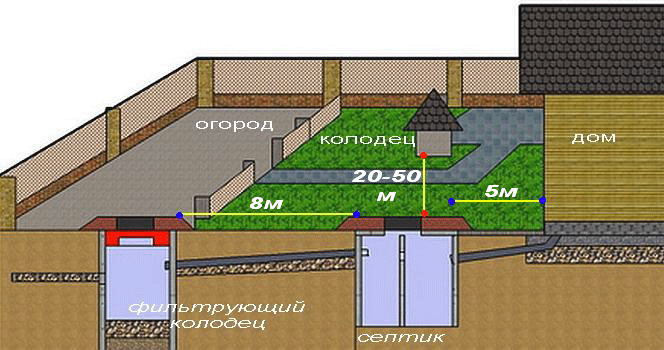 Landscape features play important role in sewer installation
Landscape features play important role in sewer installation Then comes the creation of a scheme for laying external networks. This is, respectively, a well, a pipeline outside the house and, if necessary, treatment facilities. Make your own diagram for small house one or two floors is within the power of each person, it is enough to know and pay attention to the main points. It is best to take the location of the main riser and the pipes adjacent to it for supplying water as the basis for all work. Already from them markings are made for the installation of future pipes for wastewater.
To perform these steps correctly, a large-scale plan of the house is created. The place where the riser will pass is determined and, accordingly, all plumbing equipment is displayed, taking into account the way it is connected to waste system. All pipes extending from the main riser to plumbing are drawn. All these steps must be done for each floor separately, but taking into account the features of the previous scheme, and then put together. At the same stage, the fan parameters of risers and pipes are determined. The length of all pipes is summed up with the obligatory consideration of the outlet, otherwise the scheme will not be drawn up accurately enough. Separately, a plan is drawn up for the outer part of the sewer.
What you need to know for the correct laying of sewers in depth
With the independent creation of a sewerage system in a private house, the schemes are strikingly different from those that were created according to the basic principles 20-30 years ago. Since there are a large number of new and more profitable ideas both from the material and from the practical side. The big breakthrough in this direction is the use of a septic tank, which was mentioned earlier. It is recommended to install it at a distance of at least 5 meters from the house. In depth, the septic tank is immersed in the soil by 1.5 meters, we have already written about how to choose a place for it. After determining it, it is best to mount the concrete sarcophagus. This is done to prevent the destruction of the septic tank under ground pressure, freezing and flooding with groundwater.
In accordance with the same parameters, the depth of the sewer networks is also calculated. On the segment located from the septic tank to the house, it is better to avoid a large number turns or knees as far as it. The depth of pipe laying is calculated with an emphasis on taking into account the depth of soil freezing. It is recommended that sewer pipes do not run deeper than 70-80 cm from the top layer of the earth. Those. the gasket runs a little higher than the average freezing depth. For very cold areas, for example, the far north, of course, the parameters and average values will be increased, because the soil freezes much deeper there than in other areas.
Also, the indicated values are relevant if it is not planned to place a road or other sites in this place, from which winter time snow will be removed.
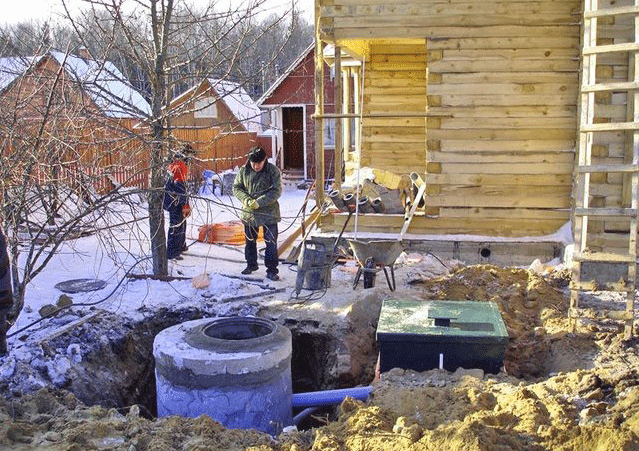 The location of the septic tank from the house should be at a distance of five meters
The location of the septic tank from the house should be at a distance of five meters How to measure depth correctly
The above tips are general canons that cannot be neglected when drawing up a sewerage system in a private house of laying depth schemes on your own. There are more specific points, taking into account which, no problems during installation drain system will not occur. These include moments such as:
- The scheme must be drawn up taking into account the diameter of the pipes. He must be pick up in optimal value by throughput.
- In the process of laying pipes, a slope must be observed, according to the norms, it is 0.03 meters for every 1 meter of pipes. This point is also required when drawing up a diagram and calculating the depth of the course.
If we talk about the slope angle, then the above value is the starting point. It can be increased due to the peculiarities of the area. Since sewage must flow down the sewer in the most natural way to prevent the occurrence of congestion. After all, it takes a lot of effort, time and money to remove them.
There are many reasons for correctly calculating the depth of the sewerage. Most of their is clear from all the points described above. But to understand how important this issue is, we should dwell on them in a little more detail. Firstly, not following the simplest rule, namely taking into account the freezing depth, the liquid in the pipes will either cool down, causing blockages, or even freeze up and lead to a rush and the need to replace part or all of the sewer pipe. It depends on the material from which it is made. A blockage that is not eliminated in time will lead to the fact that it will become impossible to use the sewer, and moreover, it can start to go out right in the bathrooms of the house.
It has already been said that it is undesirable to have a large number of joints and knees when laying an external sewer system. This is due to the fact that these moments also contribute to the appearance of blockages. If the terrain does not allow avoiding the use of knees on turns, then in these places it would be best to place a well. This will provide access to the problem area at any time necessary, as well as save money spent on troubleshooting.
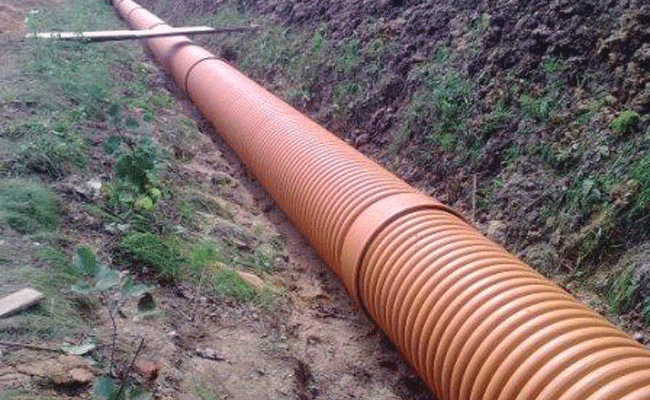 It is important to correctly measure the pipe laying depth
It is important to correctly measure the pipe laying depth Additional points when laying pipes
The long-term operation of the drain system depends not only on how correctly the sewerage system in a private house is drawn up, the laying depth scheme, but also on additional factors. The most important of them can certainly be called proper insulation. If in the warm season, in addition to groundwater, practically nothing threatens the sewer system from the outside, then in winter the situation changes. To prevent freezing, it is not enough to follow the advice indicated for the depth of the pipes, as well as the slope, etc. they need to be properly insulated.
Modern polyurethane foam insulation is now the most profitable in terms of its performance characteristics and monetary costs. Pipes made of stainless material are wrapped around it, and then covered with another layer of polyethylene on top. This is enough to provide them with maximum protection against freezing. But do not expect that in this way you can ignore the rules for calculating the depth. Special attention during the process of insulation is paid to the places of joints and turns, in order to prevent problems in the future.
If we talk about providing insulation from frost in areas where it is very cold in winter, then it is better to use more classic materials for work. These include fiberglass mineral wool. Because they do not provide the proper level of waterproofing. And moisture is harmful to pipes from any even such modern material like plastic, the polyethylene layer remains relevant.
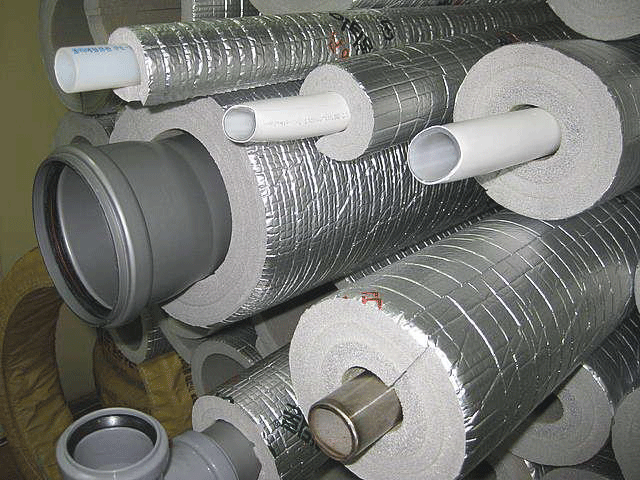 Insulation of sewer pipes
Insulation of sewer pipes What are the features of internal sewage that must be considered when developing a scheme
Almost everything that was mentioned earlier is directly related to the external wiring of wastewater. However, this is only one part of the whole scheme. There is also a second dedicated to internal wiring. In order to properly plan it, special attention must be paid to following points. First, not taking into account the fact that the number of branches in the house can be chosen at your discretion, you should not overload them with a large number of branches. The most economical, sensible, and least problematic choice is to opt for the simplest sewage system inside the house. The main principle in this process is to follow the golden rule that the flow of water should take the most natural way. To do this, pipes are laid under the floor, even if there are several floors.
If there is a decent difference in height between the internal and external sewage system, then elbows should be used to connect the pipes to each other. They should be selected in accordance with the diameter of the pipes, and also do not forget that the optimal angle is 30 degrees. It is at this value that the flow will flow smoothly and there will be no problems with congestion, etc.
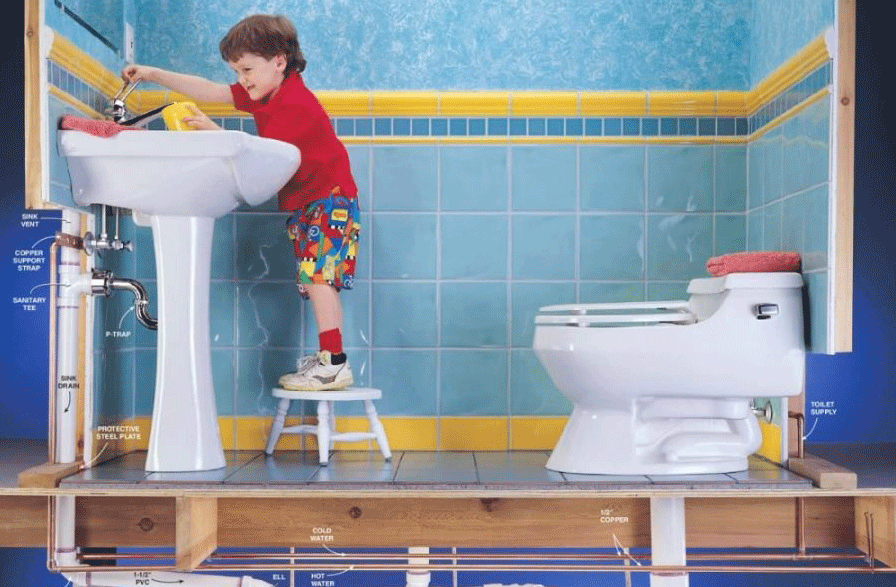 sewer drain laid under the floor
sewer drain laid under the floor As already noted when drawing up the plan, it is necessary to immediately indicate the diameter of all pipes. There are certain standards for each type of sewer pipe. They can be defined as:
- For a shower cabin, a bathtub, a toilet bowl, those that have a diameter ranging from 10 to 11 cm are suitable.
- same diameter drain pipes It is used also for the pool or a sauna.
- for washbasins, kitchen sinks a diameter of 5 cm is sufficient.
- The common drain riser, which is connected to the external sewerage system, must be equal to large diameter or even exceed it by several centimeters. Those. the diameter value should be in the region from 11 to 13 cm, taking into account the choice of pipes according to the described standards.
A good and fairly reliable material for pipes located inside the house is PVC or PP. Such pipes are most convenient for their transportation, installation, even with my own hands, since they do not require the use of specialized equipment, and are quite cheap. In addition, in any store you can easily find elbows and tees suitable for them from the same material. For joints, a simple and convenient plumbing sealant is used, i.e. there is no need to mess with the so-called beard and other outdated ways to provide insulation.
The main riser is best planned immediately in the toilet. The choice of installation method does not matter. This can be done in both hidden and open ways. Also in the plan, it is imperative to provide for the moment that collectors must be installed at the points of connection of drain pipes from sinks, bathtubs. To prevent the penetration of an unpleasant odor from the sewer system into the house, it is also necessary to install water seals. From the toilet, the length of the drain to the main drain should not exceed 1000 mm, because otherwise blockage problems cannot be avoided.
When laying pipes inside the house, it is also necessary to observe the angle of inclination, but it is somewhat different from what was indicated for the external system. As a rule, from the device to the riser, the pipe should run at a slope with indicators from 2 to 15 cm per 1 meter. If there are turns, then the knee is selected with an angle of 45 degrees. This will provide good protection from clogging and will provide quick and easy access for cleaning, if it does happen.
The presented material is sufficient in order to correctly develop a scheme for laying a sewer system for a private house. But it is always necessary to build on the specific situation. If the house is very large and it is planned to have many bathrooms, a sauna, a swimming pool, etc. then in this case it is better not to take risks and leave the plan to specially trained people. Although even in such a situation, if you show enough attention and patience, you can create a scheme yourself.








